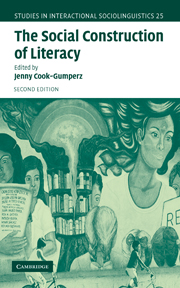Book contents
- Frontmatter
- Contents
- List of figures
- List of tables
- List of contributors
- Preface
- Acknowledgments
- 1 The social construction of literacy
- 2 Literacy and schooling: an unchanging equation?
- 3 Interactional sociolinguistics in the study of schooling
- 4 The language experience of children at home and at school
- 5 Narrative presentations: an oral preparation for literacy with first graders
- 6 Differential instruction in reading groups
- 7 Organizational constraints on reading group mobility
- 8 Developing mathematical literacy in a bilingual classroom
- 9 Spoken language strategies and reading acquisition
- 10 Speaking and writing: discourse strategies and the acquisition of literacy
- 11 The implicit discourse genres of standardized testing: what verbal analogy items require of test takers
- References
- Author index
- Subject index
6 - Differential instruction in reading groups
Published online by Cambridge University Press: 05 June 2012
- Frontmatter
- Contents
- List of figures
- List of tables
- List of contributors
- Preface
- Acknowledgments
- 1 The social construction of literacy
- 2 Literacy and schooling: an unchanging equation?
- 3 Interactional sociolinguistics in the study of schooling
- 4 The language experience of children at home and at school
- 5 Narrative presentations: an oral preparation for literacy with first graders
- 6 Differential instruction in reading groups
- 7 Organizational constraints on reading group mobility
- 8 Developing mathematical literacy in a bilingual classroom
- 9 Spoken language strategies and reading acquisition
- 10 Speaking and writing: discourse strategies and the acquisition of literacy
- 11 The implicit discourse genres of standardized testing: what verbal analogy items require of test takers
- References
- Author index
- Subject index
Summary
Preamble
In revising work conducted many years ago, it is appropriate to comment on original intentions and highlight aspects of the analysis that might now be obscure. It is also appropriate to assess the value of this work in light of what has followed. Accordingly, I comment on general intentions and analytic approach in this preface and comment on subsequent work of relevance in the afterword. The desire to revise, update, and improve is insatiable, author and text rarely being reconciled, but I have tried to resist this impulse, restricting changes in the chapter below to spelling and punctuation corrections and occasional rephrasing to clarify a sentence or passage.
The research presented in this chapter concerns different instruction strategies found among ability‐ranked groups of first‐grade students. It reports differences that are similar to what we now call ‘phonics’ versus ‘whole‐word’ literacy instruction (Coles 2000; Collins 2003; Lemann 1997), but the terms of that current controversy are too polarizing. The different groups below are having their lessons with the same teacher, and they are working through the same basal reader. It is the contention of this chapter that the differences found are not the result of a fixed and unchanging ‘teacher expectation’, nor the result of some set of reading traits or skills that distinguish the two groups of students.
- Type
- Chapter
- Information
- The Social Construction of Literacy , pp. 138 - 164Publisher: Cambridge University PressPrint publication year: 2006
- 1
- Cited by



